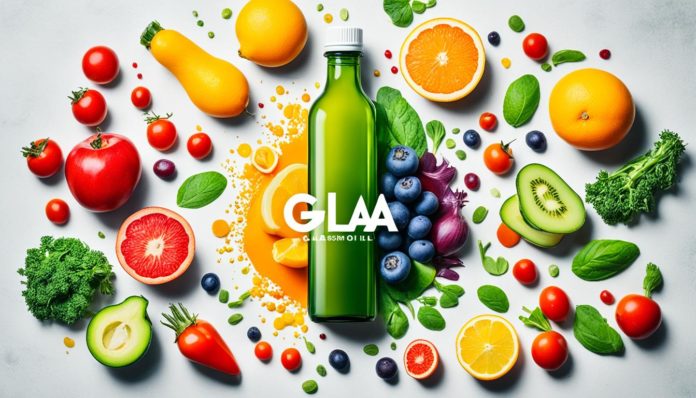Gamma-Linolenic Acid (GLA) is a must-have fatty acid for better health. It’s crucial for our well-being but our bodies can’t make it. So, we need to get it from our food or supplements. GLA is great at fighting inflammation and making your skin look better. It boosts both your body and mind.
Key Takeaways
- GLA is an essential fatty acid vital for overall well-being.
- It helps manage inflammatory conditions effectively.
- GLA plays a crucial role in improving skin health.
- Sources of GLA include diet and supplements.
- Maintaining adequate GLA levels contributes to holistic health.
Understanding Gamma-Linolenic Acid (GLA)
Gamma-linolenic acid, or GLA, is a strong Omega-6 fatty acid found in certain oils. It’s important for health because it helps our bodies work better.
What is GLA?
GLA stands out because it fights inflammation and is found in oils like evening primrose and borage. It’s special because of how our bodies use it. This process helps keep cells healthy and strong.
How GLA Works in the Body
GLA goes through a specific path in our bodies with the help of an enzyme called Delta-6-desaturase. This enzyme changes GLA, so it can help make prostaglandins. Prostaglandins control inflammation and help with many body functions.
If we don’t get enough GLA, our body’s processes might not work right. That’s why it’s key to get enough from the right sources.

Health Benefits of GLA
Gamma-Linolenic Acid (GLA) has lots of health perks. It can boost well-being with its anti-inflammatory powers and skin benefits. GLA is proving to be helpful in many health areas.
Anti-Inflammatory Properties
GLA is known for fighting inflammation. It helps manage chronic inflammation wisely. By competing with another acid, GLA cuts down on swelling-making compounds. This helps ease symptoms of chronic inflammatory diseases, offering hope for relief.

Research shows GLA supplements can make a big difference in inflammatory conditions. It makes overall health better by controlling inflammation. This may reduce the need for common anti-inflammatory drugs. Check out Mount Sinai’s overview for more on GLA and its benefits.
Skin Health and GLA
GLA is great for skin health too, especially for those with eczema. It helps the skin stay hydrated and strong. This makes it a top choice for better skin.
Studies back up GLA’s role in healthier skin. Its anti-inflammatory effect can soothe skin problems. For skin issues, GLA is highly recommended, as noted by Mount Sinai. It’s effective in treating various skin conditions.
Sources of GLA
Gamma-linolenic acid, also known as GLA, is found in certain plant-based oils. You can find it in borage oil, evening primrose oil, and black currant seed oil. These oils are rich in GLA and help keep us healthy.
These oils, like borage oil, evening primrose oil, and black currant seed oil, can be taken directly. They are also available in capsules. This makes it easy to include them in your daily routine. Health experts often suggest these oils for their GLA. They say it can help with inflammation and keep skin looking good.
GLA is hard to find in food, but these oils offer a good source. They provide a direct way to get this important fatty acid. This helps people get enough GLA for their health.
The table below shows these oils compared. It looks at their GLA content:
| Oil | GLA Concentration | Other Benefits |
|---|---|---|
| Borage Oil | ~20-26% | Supports skin health and reduces inflammation |
| Evening Primrose Oil | ~9-10% | May alleviate PMS symptoms and promote skin health |
| Black Currant Seed Oil | ~15-20% | Contains antioxidants and improves immune function |
GLA Supplements: What You Need to Know
GLA supplements offer health benefits. It’s important to know the different types and how to pick the best one for you. Knowing what affects their quality and how your body absorbs them can really help.
Types of GLA Supplements
There are many kinds of GLA supplements, each with its own benefits. The most common types include:
- Soft gel capsules
- Liquids
- Blended omega supplements
People like soft gel capsules because they’re easy to take. Liquids offer flexible dosing and might be absorbed faster. Blended omega supplements mix GLA with other fatty acids, helping to support various health benefits.
Choosing the Right GLA Supplement
Choosing a GLA supplement involves several important factors. These ensure you get a quality product. They include:
- The GLA’s source
- The dosage and concentration
- How pure it is and what additives it has
- If it’s cold-pressed to keep health properties
How well your body can use the supplement, or its bioavailability, is also key. This can depend on the mix of fatty acids and nutrients. A good mix can make the GLA work better in your body. You can learn more about essential fatty acids and their benefits here.
Buying a supplement that meets these standards will help you get the most health benefits. It means you’re making a smart choice for your health journey.
Recommended GLA Dosage
Finding the right GLA dosage means understanding there’s no set RDA for Gamma-Linolenic Acid. Still, studies suggest various dosages for different health goals. It helps to look at nutritional guidelines to match your intake with proven benefits.
Getting advice from a healthcare provider is key. They can help tailor the therapeutic dosage to your needs. Since everyone is different, doses can change based on health, age, and sex. It’s important to stick to clinical recommendations for safety and effectiveness.
| Health Concern | Suggested GLA Dosage |
|---|---|
| General Health | 200-400 mg per day |
| Inflammation | 500-1000 mg per day |
| Skin Conditions | 500-1200 mg per day |
The GLA dosage can vary greatly for different health goals. Speaking with a healthcare professional is the best way to meet your unique needs. Using up-to-date nutritional guidelines can also help shape a regimen that’s right for you, based on dependable clinical recommendations.
Research and Reviews on GLA
Exploring Gamma-Linolenic Acid (GLA) and its health effects means looking at lots of scientific studies and personal stories. A lot of research, including clinical trials and user testimonials, has shown us what GLA can do. This has given us a clear picture of its potential health benefits.
Scientific Studies on GLA
Many scientific studies have checked how GLA helps with different health issues. Lots of clinical trials have found that GLA can make a big difference for things like rheumatoid arthritis, diabetic neuropathy, and skin problems. It seems that taking GLA supplements can really help reduce inflammation and make health better. This supports the idea of using GLA in medicine.
User Reviews and Testimonials
What people say about their own experiences can tell us a lot about GLA’s benefits. Users often say their skin got better and inflammation went down. Many share that adding GLA supplements to their diet improved their health a lot. These personal stories, along with scientific evidence-based benefits, show how important GLA is for health.
Potential Side Effects of GLA
While GLA safety is widely accepted, there are some side effects to be aware of. Some people may get stomach issues, like bloating, gas, and diarrhea. They might also experience headaches from taking Gamma-Linolenic Acid.
Also, those with certain health issues or who are on other meds should be extra careful. It’s possible for contraindications to occur, so talking to a doctor before starting GLA supplements is a must. Stick to the recommended doses to avoid problems.
| Consideration | Details |
|---|---|
| Gastrointestinal Discomfort | Symptoms such as bloating, gas, and diarrhea may occur. |
| Headaches | Possible reaction leading to mild to moderate headaches. |
| Medication Interactions | Possible contraindications with other medications; consult a healthcare professional. |
| Pre-existing Conditions | Those with health conditions should seek medical advice before use. |
It’s crucial to watch how your body reacts to GLA supplements. This helps ensure responsible usage and reduces adverse effects. This way, you can find the right dosage and enjoy GLA’s benefits fully.
How to Incorporate GLA into Your Diet
Adding GLA to your diet is simple. You just need to use certain oils when you cook. Including foods rich in Gamma-Linolenic Acid (GLA) helps balance your diet. It also offers many health advantages.
Dietary Tips for Getting Enough GLA
To get enough GLA in your diet, try these easy tips:
- Use oils like borage oil, evening primrose oil, and black currant seed oil in your cooking.
- Make your salads better by adding these oils to your dressings.
- Boost your mornings. Add these oils to your smoothies.
- If adding oils to food seems hard, think about taking them as supplements instead.
Recipes Rich in GLA
Trying out new recipes can make adding GLA fun. These recipes use ingredients full of GLA:
- Salads dressed with borage oil.
- Smoothies made with evening primrose oil for energy.
- Wholesome baked goods with black currant seed oil.
Looking for GLA-rich recipes? Cookbooks focused on health often have what you need. They make adding GLA to meals easy. By using these tips and trying new recipes, you’ll enjoy GLA’s health benefits every day.
Conclusion
The therapeutic potential of Gamma-Linolenic Acid (GLA) is huge. It’s great for reducing inflammation and keeping your skin healthy. Understanding GLA and its benefits can help us stay healthy.
GLA comes from foods and supplements. If you’re thinking about taking GLA supplements, pick the right kind. You should also talk to a doctor first. This ensures the supplement fits your health plan.
Scientific studies and reviews from users can help us see if GLA is a good choice. You might find this info helpful.
Adding GLA-rich foods to your diet is easy with the right recipes and tips. Talking to health experts can help you use GLA’s benefits well. For more tips on healthy nutrients, check out our guide on the importance of magnesium. This way, you can work towards better health in a realistic way.
FAQ
What are the main benefits of Gamma-Linolenic Acid (GLA) for health?
GLA is key for reducing inflammation and boosting skin health. This essential fatty acid also supports overall wellness.
What is Gamma-Linolenic Acid (GLA)?
GLA is an Omega-6 fatty acid found in plant oils. It’s crucial for our health but our bodies can’t make it. So, we need to get it from our diet or supplements.
How does GLA work in the body?
In the body, GLA turns into prostaglandins, which help control inflammation. This transformation is vital for cell structure and health.
What are the anti-inflammatory properties of GLA?
GLA fights inflammation, aiding in managing chronic diseases. It works by competing with another acid to cut down inflammation.
How does GLA contribute to skin health?
Studies show GLA helps with skin issues like eczema. It does this by helping to form a stronger skin barrier.
What are the primary sources of GLA?
You can find GLA in high amounts in borage, evening primrose, and black currant seed oil. These are great as part of your diet or in supplements.
What types of GLA supplements are available?
GLA supplements are sold as soft gels, liquids, and in omega blends. Picking a supplement that’s easy for your body to use is key.
What is the recommended GLA dosage?
There’s no set daily amount for GLA, but doses depend on what you need it for.
It’s best to ask a healthcare expert what’s right for you.
What research supports the benefits of GLA?
Many studies have looked at GLA for arthritis, nerve pain, and skin problems. This research backs up GLA’s health perks.
Are there any potential side effects of GLA?
GLA is mostly safe but can cause stomach issues, headaches, or affect medicines. Always follow dosage advice and talk to a doctor.
How can I incorporate GLA into my diet?
For more GLA, use certain oils in your food. Add borage, evening primrose, and black currant seed oils to dressings or smoothies, or as supplements.


